Toyota Tundra Fuel Gauge Questions
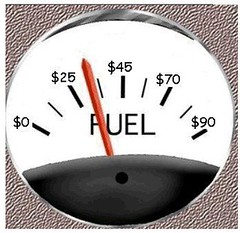 Over the past few months, we’ve received some questions about the Tundra’s fuel gauge. Basically, they all come down to this:
Over the past few months, we’ve received some questions about the Tundra’s fuel gauge. Basically, they all come down to this:
1) When my truck’s fuel gauge shows “E”, I’ve actually got quite a few gallons left in the tank. What gives?
The big reason — the fuel gauge sending unit is fairly low-tech. There’s a float in the fuel tank, and it’s somewhat inaccurate. Part of the inaccuracy is due to the technology itself — a float will rise and fall depending upon if the truck is turning, is level, has been moving recently, etc. Floats can also get “stuck”. For instance, if you leave your keys in your ignition in the “on” position (truck’s not running, but one crank and it will be) the next time you fill up, chances are when you jump in your truck to go you’ll see your fuel gauge reading less than “F”, even though you just filled it. That’s the nature of the float.
The second reason that the gauge shows “E” even though there is quite a bit of gas in the tank — the tank itself is pretty big. A big tank means that substantial changes in fuel volume don’t equal substantial changes in fuel height. You can look at my poorly drawn graphic below, but if you do the math and calculate the difference in height that the float must detect as one or two gallons leave the tank, you can imagine it’s pretty small. Combine that with the fact that the float is least accurate at the extreme ends of its range (read at empty and full), and you’ve got a formula for poor accuracy. Here’s the important part — it’s been this way for decades.
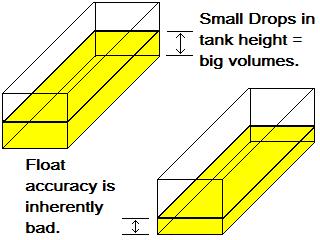
The last reason, and the best explanation for why no one has ever bothered to improve on the current system, is that auto manufacturers like the idea of a “fuel reserve”. With the exception of Toyota, nearly all manufacturers offer free roadside assistance for the first 3 years of a vehicle’s life. That roadside assistance includes bringing you gas if you were to run out. If the tank has a hidden reserve of 2 or 3 gallons below the “E” mark on the gauge, you’re much less likely to run out of gas, and thus much less likely to call roadside assistance. Also, if you’re a procrastinator like me, this reserve feature has saved your bacon a time or two.
The big issue with the Tundra — if you can call this an issue — is that the reserve in the Tundra’s tank has been reported to be as high as 6 gallons! We suspect this is one of many first-year production issues that Toyota will clear up over time.
If you want to calculate your “reserve”, simply drive your truck until your fuel gauge is reading “E” (wait until the needle points right at it). Then, when you fill up, subtract the amount of fuel you add to your truck from the listed capacity of 26 gallons. Oh yeah — make sure you’re near home when you try this out. That way someone can bring you some gas just in case your truck has no reserve (highly unlikely, but technically possible).
Product Review: Volant Cold Air Intake
We found out about the Volant’s new cold air intake for the 5.7L Tundra on TundraTalk.net, a nice forum for Tundra owners. After reading a few positive reviews from forum members, we contacted Volant and asked them if they might be interested in allowing us to review their product. They gladly accepted, and a brand new cold air intake arrived at our door.
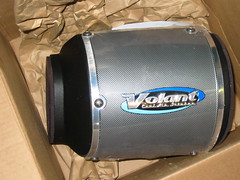 Our first impressions of the Volant intake were positive. Opening the package, we were amazed at just how simple this kit is. There’s the air box, duct, filter, some clamps, a hose connector, and some nuts and bolts. The air box’s chrome surface (see photo) is covered with plastic film to protect the finish as you install the kit — a nice touch. There’s also a brochure and some very rudimentary instructions.
Our first impressions of the Volant intake were positive. Opening the package, we were amazed at just how simple this kit is. There’s the air box, duct, filter, some clamps, a hose connector, and some nuts and bolts. The air box’s chrome surface (see photo) is covered with plastic film to protect the finish as you install the kit — a nice touch. There’s also a brochure and some very rudimentary instructions.
Speaking of instructions, installation is brutally simple. This has definitely got to be one of the highlights of this kit. Simply remove the stock air filter, engine cover, loosen a couple of clamps, unplug a couple of hoses, remove a couple of bolts, and the factory box is out of the truck. Next, you assemble the air box, bolt it into place, and reconnect all the hoses. One complaint we have – and it’s minor – is that the instructions themselves are pretty poor. They tell you how to get the job done, but we think someone should go through them and fill-in a couple of the blanks. The quality of the instructions themselves is also lacking — they look like they were made on an old zerox machine. Finally, the pages of instructions were actually stapled in the wrong order. Like we said, it’s a minor complaint — install is really easy — but the value of the kit might be a little higher if the instructions were higher quality (both in material and clarity).

Volant Air Intake Toyota Tundra Installation video
One of the other problems we have with this kit has to do with Toyota’s engine cover. First of all, in Volant’s defense, the piece of plastic that is supposed to “look like” an engine is stupid. It’s just there so that when a salesman opens the hood of the truck, he doesn’t forget the engine size and the customer can nod appreciatively and say “yes, that’s the 5.7L alright”. Basically, the engine cover is completely useless. Anyways, the problem here (and it’s minor) is that Volant’s air intake takes up some of the space that the engine cover needs to rest in. Volant provides a higher stud for the engine cover to attach to, but it’s not as solid as the factory setup. It’s not a big deal — the engine cover doesn’t do anything, doesn’t support anything, and really doesn’t need to be attached very tightly — but it would be nice if they had a solution that was a little more clever.
Fit and finish on the rest of the kit is excellent – the air box is flush against the fender and completely sealed so that only cool outside air can make it into the engine. [We’ve since been informed that the kit doesn’t completely seal against the fender. There is a small gap. Our tests indicate the gap doesn’t effect performance, but it should be noted.] This is a major selling point for Volant – they have studies that show most air boxes (both OEM and after market) let hot engine gases seep into the air the engine breathes, raising the air’s temperature and thus decreasing performance.
We have to say that the Volant kit looks awesome — it’s much more impressive than the factory air box and it looks a lot nicer than other air intakes we’ve seen. Sure, looks aren’t everything, but who doesn’t like to show off a cool accessory under the hood?
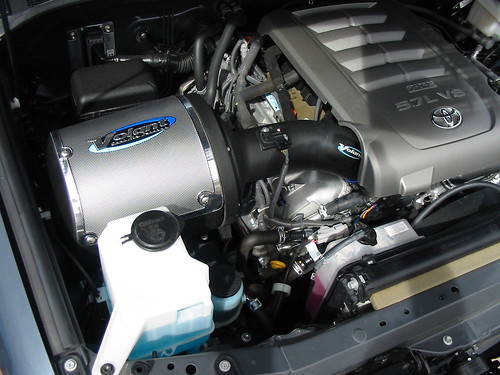
The air filter inside this kit is also a selling point for Volant. Unlike many competing companies, Volant’s PowerCore air filter is not made from cotton gauze. Instead, hundreds of staggered flutes catch 99.95% of the particulates that can damage your motor, and it does so without needing to be oiled periodically. Volant warranties their PowerCore air filters for 4 years or 100k miles, and they offer their filters in sizes that are compatible with air intakes from K&N, AEM, etc. We like the idea of a dry filter (cleaning and re-oiling filters is never fun or interesting), and we are intrigued by Volant’s claim that their filter allows better flow while catching more particulate matter.
So let’s get down to brass tax — how did the intake perform? When we first started the truck, we were amazed at how quite the Volant intake is. Whether sitting at idle or cruising down the highway, we didn’t notice any additional noise from under the hood. However, when you floor the throttle, you can hear the engine sing. Without exaggeration, you just can’t help but smile under full throttle. The sound is so pleasing to the ear, it’s like driving a race car. Very cool. We’d have to say the price of the kit might just be worth the sound alone.

Sounds of the Volant Air Intake for the Toyota Tundra – watch the video to hear the intake in operation.
Additionally, we noticed faster throttle response. Before, our test vehicle hesitated slightly on changes in throttle. With the Volant intake installed, response was almost instantaneous. The truck also felt quicker, both from a dead stop and as we accelerated on the highway. Overall, the kit seemed to make a big difference and it felt very good to drive.As far as horses are concerned, Volant claims the kit will add as much as 21hp to your Tundra’s 5.7L engine. They’ve even got the dyno graph to prove it. Looking closely at Volant’s graph, it looks like the air intake added about 14 hp at 5000 rpm, and nearly 18 hp at 5300 rpm. Our own results basically mirrored that result, but with lower magnitude. We recorded an 8 hp gain at 5000 rpm, and about 10 hp at 5350 rpm. Considering our base truck was making about 287 hp that day, and that the base truck in the Volant test was making nearly 300, we’re thinking that better conditions might have yielded better results (at least for our tests). But, like any cold air intake kit, the manufacturer’s estimates are always a little optimistic. Nonetheless, the difference we felt in power before and after was substantial. We think you can plan on seeing a gain of at least 5-10 hp, with some owners experiencing the full 21 hp Volant reports.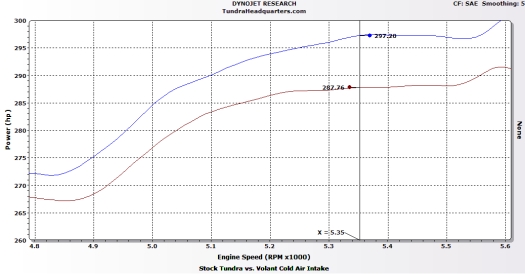
Click for larger view.
All in all, we like the Volant kit. It looks good, sounds good, drives good, and improves performance. We’re extremely confident in telling current Tundra owners that the Volant kit will add power. Like we said in our Tundra air intake guide, the factory air intake is pretty decent. But if you’re looking for a little more power, a more aggressive sounding truck (at least on WOT), or if you want to maximize horsepower gains from other accessories, installing a cold air intake makes sense.
Bottom Line: We really like the look and sound of the Volant kit. Installation is a breeze, and engine performance and throttle response were noticeably improved. We like Volant’s dry air filter, and we’ve read a lot of positive user reviews of the product. We do think the instructions could be a little nicer, and we wish they would have come up with a better way to accommodate the factory engine cover, but overall we will recommend this kit. Be sure to shop around before buying, as we found prices ranging from $360 to more than $500. NOTE: After completing this review, we learned that the kit does not seal against the fender completely. Our tests indicate the kit does add power, and we still like the look and sound, but it must be noted that the kit’s “fit and finish” is not as nice as we first reported. We’re not going to revoke our endorsement because of this issue because the kit does add power — we’ve proven that thru testing — but make sure you get this kit for discount.
Here’s a link to the least expensive Volant Cold Air Intake System we found for the new Tundra.
Consumer Reports Says New Tundra Is Below Average
Toyota quality is slipping, and Consumer Reports says it’s due in large part to the new Tundra. Evidently, Consumer Reports has found that the new Tundra, specifically the V8 4×4 model, has “below average” reliability. Even more astounding, the new Camry V6 model was also found to have “below average” reliability. Because of the poor showing of these two new models, Consumer Reports has decided that they will no longer automatically recommend new Toyota models as they have in the past. Instead, Consumer Reports says that they will now wait for a full year of survey data before making a recommendation.
Before anyone decides to return their new Tundras, we’d like to clear the air.
1. Consumer Reports shouldn’t automatically recommend any model. Ever.
While it’s great that Consumer Reports had enough confidence in the Toyota design team to automatically recommend everything Toyota made, isn’t the idea of an “automatic recommendation” a little ridiculous? After all, an independent authority should at least test a vehicle before they recommend it. Consumer Reports saying that they’re no longer going to automatically recommend Toyota is a lot like saying “as of right now, we’ve decided to do our job”. That’s hardly news.
2. The survey data is extremely tainted.
According to the press release, the data that Consumer Reports used to conclude that the Tundra is “below average” was collected in the spring of this year. Amazingly, Toyota released the Tundra in the spring of this year. The question that we have for Consumer Reports – if anyone is listening – How exactly can you determine the reliability of a vehicle that’s only been out a couple of months? How many surveys could they possibly have collected – a few dozen? Whatever the number is, it’s certainly not enough to form an opinion. After all, didn’t they say in this same press release they’re going to wait for a full year of data before making a recommendation? At best, CR‘s declaration that the Tundra is “below average” is irresponsible.
3. Toyota is still a top rated brand.
Despite the headlines, Toyota still remains one of Consumer Reports top-rated brands. According to their latest Buyer’s Guide, Toyota is still one of the best brands overall coming in behind Honda/Acura and Subaru (Scion also placed higher than Toyota, but as we all know Scion is a Toyota product). Considering that Honda/Acura and Subaru have yet to make a real truck (anyone that thinks the “Ridgeline” is a real truck needs their head examined), Toyota is still the top ranked brand that offers a real truck.
4. Toyota is a victim of it’s own success.
As we’ve said, time and again, the bar is raised much higher for Toyota than just about any other vehicle manufacturer. The recent declaration that “Toyota quality is slipping” is a great example – two models indicate “below average” and the sky officially begins to fall. Compare Toyota’s situation to GM — according to Consumer Reports, the new Pontiac Solstice and Cadillac Escalade EXT were both 220% LESS RELIABLE than an average vehicle. Of course, recent headlines about the new CR Buyer’s Guide didn’t read “Two Popular GM Models Twice As Likely To Break As Anything Else.” Maybe that’s because, unlike GM, people expect Toyota will make a good vehicle…
Toyota Tundra Bed Bounce Owner’s Survey: Initial Results
Our Toyota Tundra “Bed Bounce” owner’s survey opened on Sept. 22nd. Since that time we’ve received about 100 validated responses. Here’s the statistics we’ve compiled:
1. Nearly 79% of survey respondents have NOT filed a complaint with Toyota.
Amazingly, this problem seems to be under-reported by a factor of five. We’re not sure why people haven’t chosen to send an email or make a phone call, but we’re concerned that this lack of effort might ultimately lead to Toyota officially ignoring the issue.
2. The TRD package doesn’t seem to effect bed bounce frequency or severity.
About 51% of survey respondents reported owning a truck with the TRD package, and that percentage held for people reporting “severe” bed bounce and for those reporting “weekly” or “daily” occurrence. There’s no link we can find between the TRD package and the bed bounce problem.
3. Less than 10% of respondents described their bed bounce as “mild”.
91% of respondents stated that their bed bounce problem was “moderate” or “severe”, however, we think this is to be expected. Anyone with “mild” bed bounce might not know they even have the problem, so we’re not sure how valuable these statistics are.
4. 90% of respondents state they will modify or replace their Tundra if this problem isn’t solved.
If we assume that only people with severe problems decided to participate, this statistic makes sense. However, what doesn’t make sense (at least to us) is that while 90% of the owners will spend money to modify their suspension, replace their trucks early, or even sue Toyota, 80% of the respondents have yet to file a formal complaint…
5. 85% report experiencing bed bounce at highway speeds only.
Evidently, the anecdotes about highway bed bounce ring true — 85% of owners reported experiencing bed bounce on the highway only. Also, 69% of owners who participated reported that concrete highways were the only problem surface.
6. Basic data from the survey.
93% of respondents own the 5.7L V8.
61% of respondents drive double cabs, 36% drive the crew, and 3% drive the regular cab.
49% of respondents have owned their trucks 1 to 3 months, with the rest being evenly split between less than one month and more than 3 months.
53% of respondents rate their bed bounce as “severe”, 39% as “moderate”, and the rest as “mild”. There are no appreciable relationships between severity and truck type, nor between severity and frequency.
About 15% of survey responses were invalidated because of bogus VIN numbers or email addresses — it seems a few of our friends in the Ford, Chevy, and Dodge communities tried to participate in our survey.
Bottom Line: In our minds, our survey has been a bit of a failure. First of all, the number of responses has been very low (102 as of this posting). Also, it seems kind of foolish for TundraHeadquarters.com to lobby Toyota for action on this issue when only 20% of our survey respondents have bothered to officially report the problem. Furthermore, the data hardly seems to indicate that this issue is common. Our website receives more than 10k visitors per month, yet we have only accumulated 102 responses in 3 weeks. Granted, we don’t know for sure if all of our visitors are 2007 Tundra owners, but it seems that at least 5-10% of them would be (at a minimum). While we’ll keep our survey open through the end of October (if not longer based on response volume), at this point in time it seems the overwhelming majority of the community doesn’t find bed bounce to be too much of a problem.
To anyone who would say that they haven’t completed the survey because of privacy concerns, you’re welcome to complete the survey with a fake name. We’ve also upgraded the survey to a secure, encrypted connection. Finally, we only require a valid VIN# and a valid email address to validate a response. We’re not sure what other concerns people have, but we feel like we’ve done as much as we can to address them without ruining the validity of the survey. If you have any suggestions, or if you’d like to know more about our survey results, please contact us.
Again, if you or anyone you know hasn
Tundra Tailgate Design Flaw Update
In response to some questions about our last Tundra Tailgate post, we’ve done some more investigating, and we think we’ve figured out how why you should never drive with your Tundra’s tailgate unsecured.
1. The gas strut assist.
The Tundra’s tailgate is slam-proof because a gas strut (hidden inside the wall of the bed) reduces the effect weight of the tailgate as well as dampens any rapid movement. There is an un-intended consequence here: if the tailgate isn’t secured (i.e. in the closed position OR locked in the down position by the bed-extender or some weight) it may “levitate” at the removal angle.
2. Tailgate removal without tools.
Try this experiment: Lower your Tundra’s tailgate. Now, with it in the down position, “throw” the tailgate up into the air. When you get the force right, you’ll find that it will “hover” at about a 45 degree angle for a second or two. Keep in mind that 45 degrees is the angle you need to hold the tailgate at in order to remove it. In fact, hold the tailgate in this position and see just how easy it is for your to remove it manually. It needs just a slight lifting motion and it’s off the truck.
3. The right combination of bumps/motions will cause the tailgate to fall out.
With your tailgate hovering in the removal position, all it would take is a sudden motion that would cause your truck to lurch forward. For instance, when you hit a pot-hole, your truck first drops suddenly as it falls into the hole (thus raising your tailgate). When your truck hits the back side of the hole, your truck is not only suddenly pushed up but it is also pushed back. This backward force could be enough to dislodge the tailgate.
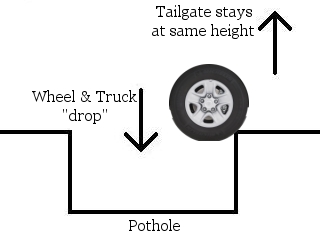
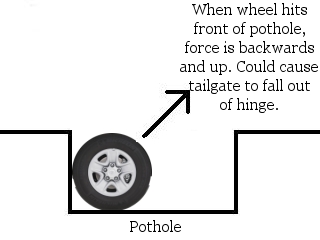
How we think unsecured tailgates can fall off of the Toyota Tundra.
4. Toyota warns you not to drive tailgate down.
If our explanation isn’t enough, check out page 35 of your owner’s manual. That’s as good of a confirmation of a flaw as you’ll see from an auto manufacturer.
Bottom Line: Our previous tailgate warning was incorrect – you can drive with your tailgate down, but only if it’s locked into that position by the bed extender or the load you’re carrying. Otherwise, you should drive with the tailgate up. If it’s free to move, there’s a chance it will fall out. Thanks again to Glenn for bringing this to our attention. Also, while we’re on the subject, you should always lock your tailgate when you park your truck outside (the tailgate is just too easy to steal).

